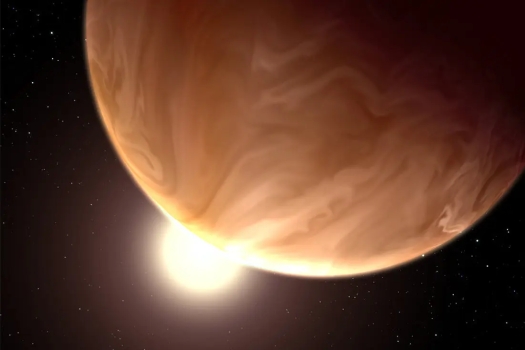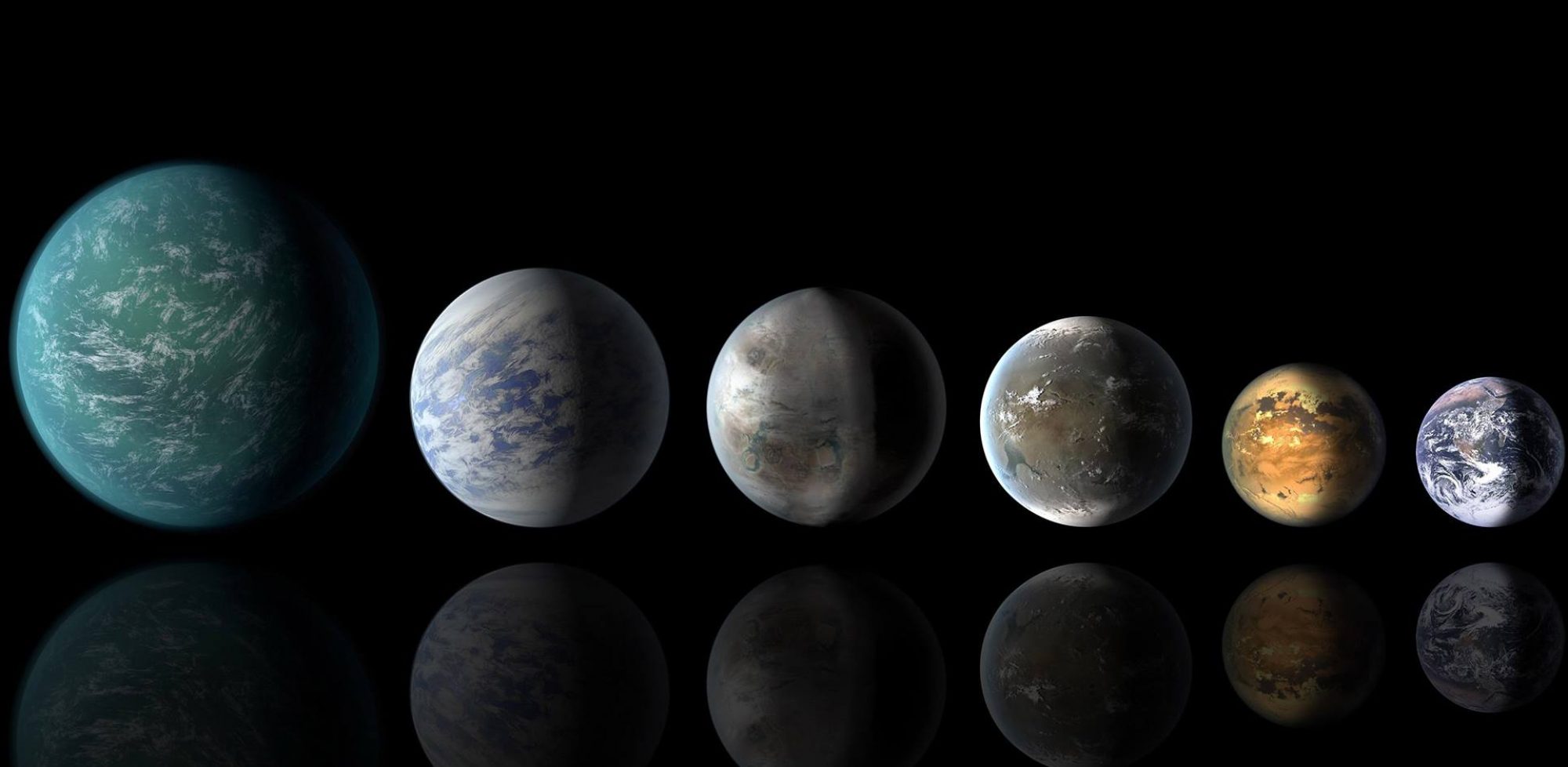
The decades-long process of developing, refining, testing, launching, unfurling and now aligning and calibrating the most capable space telescope in history is nearing fruition. While NASA has already released a number of “first light” images of photons of light moving through the James Webb Space Telescope’s optical system, the jaw-dropping “first light” that has all the mirrors up and running together to produce an actual scientific observation is a few months off.
Just as the building and evolution of the Webb has been going on for years, so has the planning and preparation for specific team observation “campaigns.” Many of these pertain to the earliest days of the universe, of star and galaxy formation and other realms of cosmology, but an unprecedented subset of exoplanet observations is also on its way.
Many Worlds earlier discussed the JWST Early Release Science Program, which involves observations of gigantic hot Jupiter planets to both learn about their atmospheres and as a way to collect data that will guide exoplanet scientists in using JWST instruments in the years ahead.
Now we’ll look at a number of specific JWST General Observation and Guarantreed Time efforts that are more specific and will collect brand new information about some of the major characteristics and mysteries of a representative subset of the at least 100 billion exoplanets in our galaxy.
This will be done by using three techniques including transmission spectroscopy — collecting and analyzing the light that passes through an exoplanet’s atmosphere as it passes in front of its Sun. The JWST will bring unprecedented power to characterizing the wild diversity of exoplanets now known to exist; to the question of whether “cool” and dim red dwarf stars (by far the most common in the galaxy) can maintain atmospheres; to newly sensitive studies of the chemical makeup of exoplanet atmospheres; and to the many possibilities of the TRAPPIST-1 exoplanets, a seven rocky planet solar system that is relatively nearby.

One of the puzzles of our known solar system is that it does not have any planets in the size range of super-Earths (with radii up to 1.5 times that of Earth) or any sub-Neptunes (with radii of 1.8 times of Earth and above, but smaller than Neptune.)
The Kepler Space Telescope found that planets in these sizes were by far the most common in the galaxy, or at least the most common observed so far. So exoplanet scientists are eager to know more about their atmospheres, their composition, and their inferred patterns of migration as ways to learn much more about, among other things, how they form and why they didn’t form in our solar system.

A group led by Natasha Batalha of NASA’s Ames Research Center has been allocated a substantial and unusual 141 JWST hours to study a set of 11 planets (some terrestrial and some gaseous) in these size and mass ranges.
Project co-PI Johanna Teske, a staff scientist at the Carnegie Institute of Science in Washington, said that their primary goals include determining whether planet size in this range has a direct correlation with whether or not the planet has an atmosphere, and what kind of atmospheres they might be.
When first formed, planets like these generally have what is called an “envelope” of hydrogen and helium around them. This is the “primordial” atmosphere. But planets can later have a “secondary” atmosphere that include molecules cycled from inside the planet to the atmosphere — carbon dioxide, methane, water vapor and more.

These planets can have thick clouds and hazes around them, making it near impossible for current telescopes to confidently detect these volatile secondary atmosphere elements. Because JWST is an infrared telescope, it can cut through hazes because of the wavelengths that it uses. And because of its unprecedented precision, it will be able to identify the components of a secondary atmosphere as never before.
There is also a puzzling dip in this census of super-Earth to mini-Neptune sized planets, with planets in the range of 1.7 Earth radii being much less common that those somewhat larger or somewhat smaller. “Perhaps,” Teske said, “this dip will give us insight into how planets of this range of sizes are formed.” Or regarding the dip, are not formed.
Teske also reminded that the long-held view that our solar system has no planets in the super-Earth to mini-Neptune size may some day need an asterisk. This is because a number of astronomers have found preliminary signs of a planet perhaps of these sizes out well beyond Pluto. Sometimes called Planet 9 or Planet X, it is a subject of substantial scientific debate and might, some day, make our solar system a more conventional one in terms of its planetary make-up.

One of the more pressing questions of exoplanet science is whether planets that orbit red dwarf (or M dwarf) stars can have atmospheres. This is so central because some 75 percent of the stars in our galaxy and 50 of the 60 stars nearest to us are this variety. M-dwarf stars are relatively small and dim, “cool” when compared with suns like our own, and often orbited by planets much closer in than Mercury.
A major Cycle 1 project will use JWST to intensively examine 9 planets orbiting red dwarf stars (from two different programs) to determine whether or not they have atmospheres. Led by Principal Investigator Kevin Stevenson of the Applied Physics Lab (APL) of Johns Hopkins University PI and Co-PI Jacob Lustig-Yaeger, also with APL, the team will take on this basic question in the search for habitable planets.
The potential problems for habitability of planets orbiting red dwarfs center around the fact that the planets are so close to the host stars they will likely be tidally locked (with one side always facing its host star, like our moon) and also that red dwarfs in their relatively early days tend to send out many and large solar flares. The question of whether those flares could and would permanently sterilize orbiting planets has been the subject of intense debate.
But now, Stevenson said, the JWST will be able to determine whether any of the red dwarf planets actually have atmospheres, and if so how common those atmospheres might be. If atmospheres are found, the next step will be to detail as much as possible about what chemicals are present.
“If all or many M-dwarf planets we study have atmospheres, that will tell us they should be studied for possible habitability,” Stevenson said. “But if they don’t have atmospheres, then we have to rethink our strategy about looking for planets that might support life.”
The study will also look at the role of planetary migration — moving from further out and away from full force of the flares to later closer in — in determining whether a red dwarf exoplanet has an atmosphere, and
“Inevitably, this study will bring new sparks of life to the study of M-dwarf planets.”

The TRAPPIST-1 solar system almost universally considered among the most compelling, if not the most compelling exo-system found so far. It has seven rocky planets orbiting close to its host star, all have similar densities and three appear to be within the habitable zone of the system — the distance from the star at which water can be liquid.
TRAPPIST-1e is one of those habitable planets and will be the focus of a major Cycle 1 JWST observing run.
TRAPPIST-1e is similar to Earth’s mass, radius, density, gravity, temperature, and the amount of sunlight per relative unit that it receives. It has also been confirmed that the planet does not have a hydrogen-dominated atmosphere, meaning it is more likely to have a compact atmosphere like the terrestrial planets in our solar system. (Hydrogen is a strong greenhouse gas, and so a hydrogen atmosphere will make a planet’s surface uninhabitale.)
Ryan MacDonald, a postdoc at Cornell’s University’s Carl Sagan Institute, will be part of the team that analyzes data from the TRAPPIST-1e observation, which is led by Cornell astrophysicist Nikole Lewis.

“Carbon dioxide is very detectable and we think we’ll get it,” he said. “If we do, then we’ll move on to water vapor and then methane. That can be either geological or biological, but if we find it we’ll then be looking for gases associated with life.” While it may well be possible to find the carbon dioxide during the Cycle 1 observations, the other molecules would require more observing time in future years, MacDonald said.
The most significant gas to find would probably be oxygen (O2) but it would require an unlikely 1,000 observed transits in the wavelengths available on JWST. If and when a team has sufficient observing time, it can look instead for ozone (O3) as a proxy — a light-modified form of oxygen that would be easier to detect with some 100 to 200 observed transits needed, which is perhaps possible over a number of years.
Finding methane and ozone both in the TRAPPIST-1e atmosphere would be a potential signal of life, but making both those detections would constitute pulling several inside straights.
And, of course, TRAPPIST-1e might be a bare rock with no atmosphere. It circles its M-dwarf star in six days and so could have been sterilized by early flaring.
So far observations using numerous telescopes have not found an atmosphere or chemicals surrounding the planet, something that could be a result of thick clouds surrounding the planet or that it is indeed a bare rock.
Nonetheless, there is great excitement about the many TRAPPIST-1 observations.
“We’re aware of the known unknowns, but there will almost certainly be unknowns we hadn’t considered,” MacDonald said. “And because (TRAPPIST) 1e has so many features that could be consistent with a habitable planet, it has a lot to tell us.”

HD 189733b is the archetype of a hot Jupiter planet. Detected in 2005, it is quite large (with a radius 13 percent greater than our Jupiter), very bright and has a high signal-to-noise ratio — i.e., the measure of the power of desired signal relative to the background noise level.
Because it is so well known and its chemical makeup potentially so accessible, University of Maryland research professor Drake Deming proposed undertaking a “deep, molecular study” of the planet with the JWST.

The goal of the effort is to detect and quantify chemicals not easy to find without the powerful, infrared observing capabilities of the JWST — hydrogen cyanide, carbon monoxide, methane and silicon dioxide in the clouds, as well as other molecules produced by unusual processes.
“What we want to do is observe among the most favorable planets for collecting data and to do it extremely well,” said Deming. “We’ll be looking for the weakest possible signals of low abundance chemicals, and in that way will hopefully show the community what the telescope can do and how.”
“What the community wants s to understand the chemistry and atmospheres of rocky, temperate planets, and they want to look for biosignatures. But just like Olympic sprinters who have to learn to walk before they can run, a giant planet like this is just easier to understand and to find that chemistry.”
“If we couldn’t understand the make-up of the highest signal-to-noise giant planet– where we have lots of molecules and can detect at high sensitivity– then there no real hope of understanding the cooler, smaller planets we are ultimately interested in. So this is a step in that direction.”
